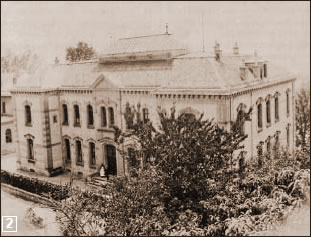|
 |
 |
|
|
|
 |
Jules Gonin. Pioneer of Retinal Detachment
Surgery
Thomas J Wolfensberger, MD, PD, MER
Before the turn of the 20th century, eyes with a retinal
detachment were considered doomed. Contrary to other branches
of ophthalmology, such as cataract extraction, the surgical
treatment of retinal detachment was still in its infancy,
and the surgical success rates were less than five percent.
From 1902 to 1921 Jules Gonin almost single handedly changed
the landscape of retinal detachment surgery forever. He
recognised that the retinal break was the cause . and
not the consequence as it was largely believed at the
time - of the retinal detachment, and that the treatment
had at all costs to comprise the closure of the break
by cauterisation. He named the procedure ignipuncture,
as he cauterised the retina through the sclera with a
very hot pointed instrument. Despite rigorously detailed
clinical observations and increasing success rates, his
discovery was not readily accepted and sometimes openly
opposed by a large part of the ophthalmic establishment.
It was not until 1929 that he received worldwide acclaim
at the International Ophthalmological Congress in Amsterdam
for his surgical technique. His legacy lives on in the
eye hospital in Lausanne that bears his name, in the Gonin
Medal awarded by the International Council of Ophthalmology
every four years for the highest achievement in ophthalmology,
and in a street named after him, the very street that
he used to walk from his home to the hospital every day.
The importance of Jules Gonin in the development of modern
retinal detachment surgery cannot be underestimated. Between
1902 and 1921 he developed his understanding of how retinal
detachments formed and how they had to be effectively
treated. The story of his life is an illustration of how
an ophthalmologist persevered with his diligent studies
for almost 20 years until his research bore its fruits.
Early years
Jules Gonin was born in Lausanne, the French part of Switzerland
on 10 August 1870. In the 17th century, his ancestors
had been forced to leave their native Piedmont in the
north of Italy due to religious persecution. The young
Jules grew up in a family where culture and religious
faith were the pillars of communal, and his schooling
at the local Lycée soon started to show his extraordinary
talent for languages. He spoke French, Swiss German, and
added Latin and Greek with little effort. He also studied
English, Spanish and Italian and became proficient in
all of them. 1
In 1888 he enrolled in the College of Sciences
and studied medicine at the University of Lausanne. He
was very active in his fraternity called the Zofingia,
and lobbied hard to abolish certain fencing rituals that
were a part of the group's activities. After completing
some research studies on butterflies, which earned him
a distinction from the University, he entered the Institute
of Pathology in Lausanne. After several travels around
Europe during 1894-1895 to visit different hospitals in
Paris, London, Berlin, Heidelberg, Vienna and Prague,
he was drawn to ophthalmology. Dr. Marc Dufour, the director
of the Eye Hospital in Lausanne at the time, offered him
a post in 1896 to start his training. The Eye Hospital
in Lausanne had started off as an asylum for the blind
built in the first half of the 19th century (Figure 1).

Figure 1. Asylum for the blind in
Lausanne built in the first
half of the 19th century. This building was the first
step to
establish an eye clinic in Lausanne several years later.
(From:"Asile des Aveugles" Lausanne, 1985)
In 1873 a new hospital was erected next to it and it was
only then that a proper eye department was opened with
a permanent medical staff (Figure 2).

Figure 2. View of the new Eye Hospital
which was built in 1873. This
building was commissioned by the Foundation, which had
put into place the asylum for the blind in the first place
in
1843. (From: "Asile des Aveugles" Lausanne,
1985)
|
|
 |
|
 |
| |